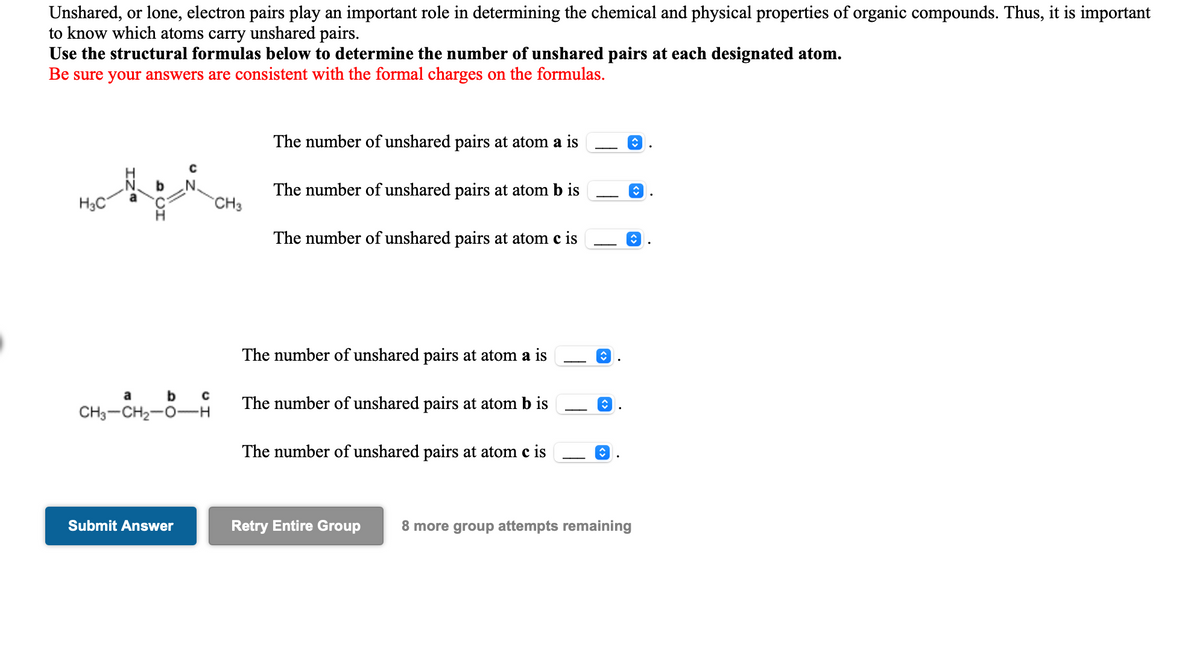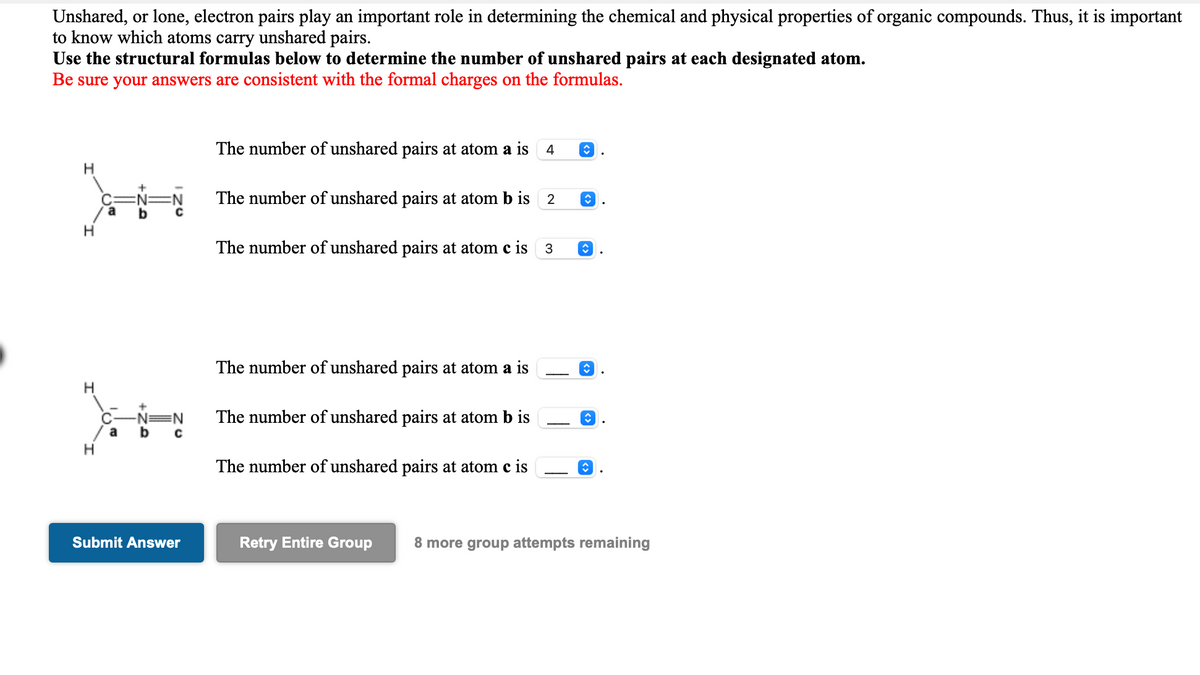Unshared, or lone, electron pairs play an important role in determining the chemical and physical properties of organic compounds. Thus, it is important to know which atoms carry unshared pairs. Use the structural formulas below to determine the number of unshared pairs at each designated atom. Be sure your answers are consistent with the formal charges on the formulas. The number of unshared pairs at atom a is The number of unshared pairs at atom b is H3C CH3 The number of unshared pairs at atom c is The number of unshared pairs at atom a is b The number of unshared pairs at atom b is CH3-CH2-0-H The number of unshared pairs at atom c is Submit Answer Retry Entire Group 8 more group attempts remaining
Unshared, or lone, electron pairs play an important role in determining the chemical and physical properties of organic compounds. Thus, it is important to know which atoms carry unshared pairs. Use the structural formulas below to determine the number of unshared pairs at each designated atom. Be sure your answers are consistent with the formal charges on the formulas. The number of unshared pairs at atom a is The number of unshared pairs at atom b is H3C CH3 The number of unshared pairs at atom c is The number of unshared pairs at atom a is b The number of unshared pairs at atom b is CH3-CH2-0-H The number of unshared pairs at atom c is Submit Answer Retry Entire Group 8 more group attempts remaining
Chapter1: Lewis Structures
Section: Chapter Questions
Problem 33EQ: The Lewis structure of acetone is Circling the carbonyl carbon, i.e., the carbon atom attached to...
Related questions
Question

Transcribed Image Text:Unshared, or lone, electron pairs play an important role in determining the chemical and physical properties of organic compounds. Thus, it is important
to know which atoms carry unshared pairs.
Use the structural formulas below to determine the number of unshared pairs at each designated atom.
Be sure your answers are consistent with the formal charges on the formulas.
The number of unshared pairs at atom a is
The number of unshared pairs at atom b is
CH3
The number of unshared pairs at atom c is
The number of unshared pairs at atom a is
а b с
CH3-CH2-0-H
The number of unshared pairs at atom b is
The number of unshared pairs at atom c is
Submit Answer
Retry Entire Group
8 more group attempts remaining

Transcribed Image Text:Unshared, or lone, electron pairs play an important role in determining the chemical and physical properties of organic compounds. Thus, it is important
to know which atoms carry unshared pairs.
Use the structural formulas below to determine the number of unshared pairs at each designated atom.
Be sure your answers are consistent with the formal charges on the formulas.
The number of unshared pairs at atom a is
4
The number of unshared pairs at atom b is 2
H
The number of unshared pairs at atom c is
3
The number of unshared pairs at atom a is
The number of unshared pairs at atom b is
C-NEN
а b
H
The number of unshared pairs at atom c is
Submit Answer
Retry Entire Group
8 more group attempts remaining
Expert Solution
This question has been solved!
Explore an expertly crafted, step-by-step solution for a thorough understanding of key concepts.
This is a popular solution!
Trending now
This is a popular solution!
Step by step
Solved in 2 steps with 2 images

Knowledge Booster
Learn more about
Need a deep-dive on the concept behind this application? Look no further. Learn more about this topic, chemistry and related others by exploring similar questions and additional content below.Recommended textbooks for you


Chemistry: An Atoms First Approach
Chemistry
ISBN:
9781305079243
Author:
Steven S. Zumdahl, Susan A. Zumdahl
Publisher:
Cengage Learning

Chemistry
Chemistry
ISBN:
9781305957404
Author:
Steven S. Zumdahl, Susan A. Zumdahl, Donald J. DeCoste
Publisher:
Cengage Learning


Chemistry: An Atoms First Approach
Chemistry
ISBN:
9781305079243
Author:
Steven S. Zumdahl, Susan A. Zumdahl
Publisher:
Cengage Learning

Chemistry
Chemistry
ISBN:
9781305957404
Author:
Steven S. Zumdahl, Susan A. Zumdahl, Donald J. DeCoste
Publisher:
Cengage Learning


Principles of Modern Chemistry
Chemistry
ISBN:
9781305079113
Author:
David W. Oxtoby, H. Pat Gillis, Laurie J. Butler
Publisher:
Cengage Learning

Chemistry: The Molecular Science
Chemistry
ISBN:
9781285199047
Author:
John W. Moore, Conrad L. Stanitski
Publisher:
Cengage Learning